Taxonomy
The unique mouthparts of soapberry bugs place them in the order Hemiptera and their lack of relatively well-developed scent glands places them in the family Rhopalidae. Soapberry bugs specifically encompass all species within the subfamily Serinethinae. Serinethinae contains three genera: Jadera, Leptocoris, and Boisea. Members of the genus Jadera are distinguished by the two very long plates (bucculae) on the underside of their head. These plates are very short on the heads of those within the genera Leptocoris and Boisea. Members of the genera Leptocoris and Boisea can be distinguished from one another by the relative shape of their thorax; those within Leptocoris have a thorax that appears short and wide, whereas those within Boisea have a thorax that appears long and thin. With only four species, Boisea is also substantially less speciose than Leptocoris and Jadera. In total, there are about 60 species of soapberry bug.
Behavior
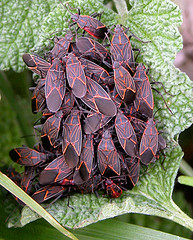
Despite the fact that the soapberry bugs belong to the family of insects referred to as the scentless plant bugs, they are actually quite redolent. When disturbed, soapberry bugs release a pungent, odorous substance that discourages predation and renders them unpalatable (possibly even poisonous). It is thought that their bright coloration and strong odor serve to advertise their unpalatability to potential predators; this phenomenon, a common type of antipredator adaptation, is known as aposematism. Their aposematism is effective and permits them to fearlessly aggregate on trees, rocks, and man-made structures to sun themselves. These aggregations often consist of hundreds and sometimes even millions of soapberry bugs.
Feeding
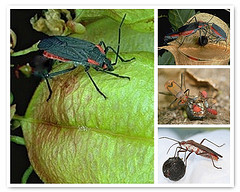
Soapberry bugs feed on the seeds of sapinds by using a beak-like structure to pierce or reach inside of the fruit containing the seeds. Once the seed has been reached, soapberry bugs use their beak to pierce the seed coat and inject digestive substances into the seed itself. They then suck up and consume the digested seed material. Soapberry bugs have adapted to the varying shapes and sizes of sapind fruits by developing beak lengths specific to the sapind that they specialize on. If a sapind has fruits with seeds that lie very deep within the fruit, the soapberry bugs that live on that plant will have very long beaks to reach those seeds. If a sapind has fruits with seeds that lie nearer to the surface of the fruit, the soapberry bugs that live on that plant will have shorter, less unwieldy beaks. Young insects, or nymphs, whose beaks are still growing may crawl inside of fruits to feed or they may simply feed on exposed seeds that have fallen to the ground. Adults with fully developed beaks may do the same, and there are some populations of soapberry bugs that feed, live, and reproduce almost exclusively on the ground.
Life history
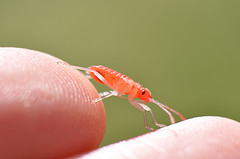
The soapberry bug life cycle seems straightforward: male and female mate, the female lays eggs, the young hatch from the eggs, grow, and cast off their skin (molt) as they go through several developmental stages called instars. Finally, adulthood (along with a fully developed set of wings) and reproductive maturity are achieved and the cycle begins again. However, several aspects of this cycle are more complex than they initially appear. Firstly, just because a male mates with a female, does not necessarily mean that he will father her offspring. In soapberry bugs (and many other organisms), the sperm of the male that was the last to mate with the female has precedence over the sperm deposited by those that mated with her previously. Thus, natural selection favors males with the behavior, morphology, and physiology that increase the chance that they will be the last male to mate with any given female before she lays her eggs. This phenomenon inevitably contributes to reproductive competition between males.
Further adding to this competition is the fact that, in certain climates, females are scarcer than males due to higher female mortality rates. This means that males not only have to compete with one another to be the last male that has mated with any given female, they also have to compete with one another to find a female to mate with in the first place. Intense competition can lead to the practice of mate guarding, where a male copulates with a female long after insemination has occurred, only withdrawing temporarily to allow her to lay her eggs. Males may guard their mates for well over 24 hours straight. Some even remain in copula with females that have died during mating.
As previously mentioned, Hemipteran adulthood comes with a pair of wings; but this does not necessarily mean that such wings are functional. Wings and their associated flight muscles require much energy to use and maintain, making them very energetically expensive. Therefore, likely due to the advantages of energetic savings, some soapberry bugs are short-winged (or brachypterous) and are unable to fly because their wings are too short and their flight muscles underdeveloped. Other soapberry bugs are long-winged, or macropterous, and have wings that are sufficiently long for flying. However, not all macropterous soapberry bugs can fly; there exists a cryptic morph of flightless soapberry bug. Such cryptic morphs have long wings, but cannot actually fly because their flight muscles never developed or have been histolyzed. This allows certain macropterous soapberry bugs to save energy similarly to their brachypterous counterparts.
Variation in adults and juveniles
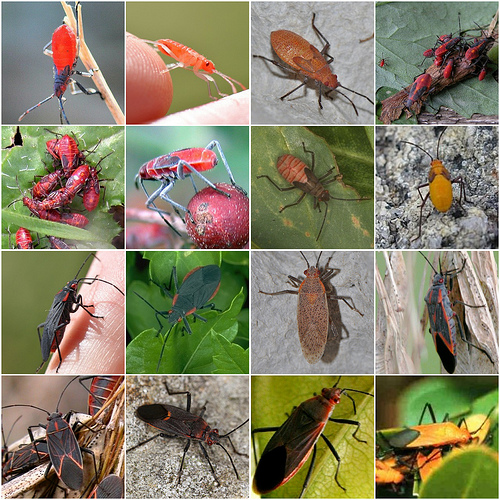
There is much variation between adult soapberry bug species. Different morphology, coloration, and patterns are almost always seen between species. Leptocoris vicinus are bright red with a characteristic black 'v' shape along the clavus, Jadera haematoloma are jet black with so-called "red shoulders", Boisea fulcrata are petite with fine orange lines tracing the veins of their coria. Such variation can sometimes be seen within a single species. Some Leptocoris hexophthalma are very slender, others are not; some are army green, while others are bright red or nearly black. Similarly, the large-bodied Leptocoris abdominalis can be red, ochre, or anything in between.
However, despite such incredible variation in their adult counterparts, juvenile soapberry bugs are surprisingly similar in structure and appearance. First instar soapberry bugs are so tiny and compact that even different genera can be hard to distinguish. As they grow, different colors and patterns on their bodies become increasingly conspicuous. Often such features are indicative of the variation they will exhibit as adults. Young Jadera coturnix have orange bodies that are finely punctated, just like the bodies and wings of adults. By the fourth instar, Jadera haematoloma have the red shoulders that so clearly define them upon adulthood. And by the end of the first instar Leptocoris productus exhibit the same bright orange coloration that characterizes them during adulthood.
Human-insect interactions
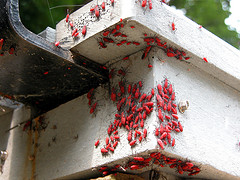
When soapberry bugs aggregate on, within, or near man-made structures, they can be a nuisance. Although completely harmless to humans, their very presence may annoy and frighten people. Additionally, their waste can leave small reddish stains on surfaces, which can be frustrating and difficult to remove. Soapberry bugs can also be minor agricultural pests when they pierce foliage and fruits on trees, which damages crops meant for human consumption. However, nowhere are they serious agricultural pests.


